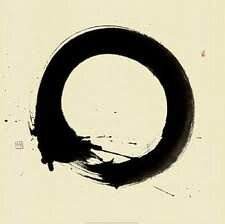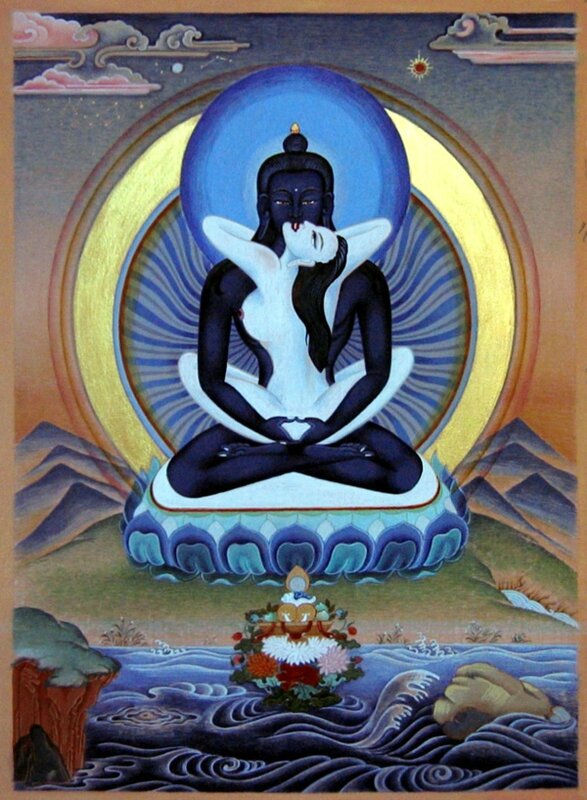9. The Dharma-Door of Nonduality (chap 9 de VIMALAKIRTI NIRDESA)
Then, the Licchavi Vimalakirti asked those bodhisattvas, "Good sirs, please explain how the bodhisattvas enter the Dharma-door of nonduality!"
The bodhisattva Dharmavikurvana declared, "Noble sir, production and destruction are two, but what is not produced and does not occur cannot be destroyed. Thus the attainment of the tolerance of the birthlessness of things is the entrance into nonduality."
The bodhisattva Srigandha declared, "'I' and 'mine' are two. If there is no presumption of a self, there will be no possessiveness. Thus, the absence of presumption is the entrance into nonduality."
The bodhisattva Srikuta declared, "'Defilement' and 'purification' are two. When there is thorough knowledge of defilement, there will be no conceit about purification. The path leading to the complete conquest of all conceit is the entrance into nonduality."
The bodhisattva Bhadrajyotis declared, "'Distraction' and 'attention' are two. When there is no distraction, there will be no attention, no mentation, and no mental intensity. Thus, the absence of mental intensity is the entrance into nonduality."
The bodhisattva Subahu declared, "'Bodhisattva-spirit' and 'disciple-spirit' are two. When both are seen to resemble an illusory spirit, there is no bodhisattva-spirit, nor any disciple-spirit. Thus, the sameness of natures of spirits is the entrance into nonduality."
The bodhisattva Animisa declared, "'Grasping' and 'nongrasping' are two. What is not grasped is not perceived, and what is not perceived is neither presumed nor repudiated. Thus, the inaction and noninvolvement of all things is the entrance into nonduality."
The bodhisattva Sunetra declared, "'Uniqueness' and 'characterlessness' are two. Not to presume or construct something is neither to establish its uniqueness nor to establish its characterlessness. To penetrate the equality of these two is to enter nonduality."
The bodhisattva Tisya declared, "'Good' and 'evil' are two. Seeking neither good nor evil, the understanding of the nonduality of the significant and the meaningless is the entrance into nonduality."
The bodhisattva Simha declared, "'Sinfulness' and 'sinlessness' are two. By means of the diamond-like wisdom that pierces to the quick, not to be bound or liberated is the entrance into nonduality."
The bodhisattva Simhamati declared, "To say, 'This is impure' and 'This is immaculate' makes for duality. One who, attaining equanimity, forms no conception of impurity or immaculateness, yet is not utterly without conception, has equanimity without any attainment of equanimity - he enters the absence of conceptual knots. Thus, he enters into nonduality."
The bodhisattva Suddhadhimukti declared, "To say, 'This is happiness' and 'That is misery' is dualism. One who is free of all calculations, through the extreme purity of gnosis - his mind is aloof, like empty space; and thus he enters into nonduality."
The bodhisattva Narayana declared, "To say, 'This is mundane' and 'That is transcendental' is dualism. This world has the nature of voidness, so there is neither transcendence nor involvement, neither progress nor standstill. Thus, neither to transcend nor to be involved, neither to go nor to stop - this is the entrance into nonduality."
The bodhisattva Dantamati declared, "'Life' and 'liberation' are dualistic. Having seen the nature of life, one neither belongs to it nor is one utterly liberated from it. Such understanding is the entrance into nonduality."
The bodhisattva Pratyaksadarsana declared, "'Destructible' and 'indestructible' are dualistic. What is destroyed is ultimately destroyed. What is ultimately destroyed does not become destroyed; hence, it is called 'indestructible.' What is indestructible is instantaneous, and what is instantaneous is indestructible. The experience of such is called 'the entrance into the principle of nonduality.'"
The bodhisattva Parigudha declared, "'Self' and 'selflessness' are dualistic. Since the existence of self cannot be perceived, what is there to be made 'selfless'? Thus, the nondualism of the vision of their nature is the entrance into nonduality."
The bodhisattva Vidyuddeva declared, "'Knowledge' and 'ignorance' are dualistic. The natures of ignorance and knowledge are the same, for ignorance is undefined, incalculable, and beyond the sphere of thought. The realization of this is the entrance into nonduality."
The bodhisattva Priyadarsana declared, "Matter itself is void. Voidness does not result from the destruction of matter, but the nature of matter is itself voidness. Therefore, to speak of voidness on the one hand, and of matter, or of sensation, or of intellect, or of motivation, or of consciousness on the other - is entirely dualistic. Consciousness itself is voidness. Voidness does not result from the destruction of consciousness, but the nature of consciousness is itself voidness. Such understanding of the five compulsive aggregates and the knowledge of them as such by means of gnosis is the entrance into nonduality."
The bodhisattva Prabhaketu declared, "To say that the four main elements are one thing and the etheric space-element another is dualistic. The four main elements are themselves the nature of space. The past itself is also the nature of space. The future itself is also the nature of space. Likewise, the present itself is also the nature of space. The gnosis that penetrates the elements in such a way is the entrance into nonduality."
The bodhisattva Pramati declared, "'Eye' and 'form' are dualistic. To understand the eye correctly, and not to have attachment, aversion, or confusion with regard to form - that is called 'peace.' Similarly, 'ear' and 'sound,' 'nose' and 'smell,' 'tongue' and taste,' 'body' and touch,' and 'mind' and 'phenomena' - all are dualistic. But to know the mind, and to be neither attached, averse, nor confused with regard to phenomena - that is called 'peace.' To live in such peace is to enter into nonduality."
The bodhisattva Aksayamati declared, "The dedication of generosity for the sake of attaining omniscience is dualistic. The nature of generosity is itself omniscience, and the nature of omniscience itself is total dedication. Likewise, it is dualistic to dedicate morality, tolerance, effort, meditation, and wisdom for the sake of omniscience. Omniscience is the nature of wisdom, and total dedication is the nature of omniscience. Thus, the entrance into this principle of uniqueness is the entrance into nonduality."
The bodhisattva Gambhiramati declared, "It is dualistic to say that voidness is one thing, signlessness another, and wishlessness still another. What is void has no sign. What has no sign has no wish. Where there is no wish there is no process of thought, mind, or consciousness. To see the doors of all liberations in the door of one liberation is the entrance into nonduality."
The bodhisattva Santendriya declared, "It is dualistic to say 'Buddha,' 'Dharma,' and 'Sangha.' The Dharma is itself the nature of the Buddha, the Sangha is itself the nature of the Dharma, and all of them are uncompounded. The uncompounded is infinite space, and the processes of all things are equivalent to infinite space. Adjustment to this is the entrance into nonduality."
The bodhisattva Apratihatanetra declared, "It is dualistic to refer to 'aggregates' and to the 'cessation of aggregates.' Aggregates themselves are cessation. Why? The egoistic views of aggregates, being unproduced themselves, do not exist ultimately. Hence such views do not really conceptualize 'These are aggregates' or 'These aggregates cease.' Ultimately, they have no such discriminative constructions and no such conceptualizations. Therefore, such views have themselves the nature of cessation. Nonoccurrence and nondestruction are the entrance into nonduality."
The bodhisattva Suvinita declared, "Physical, verbal, and mental vows do not exist dualistically. Why? These things have the nature of inactivity. The nature of inactivity of the body is the same as the nature of inactivity of speech, whose nature of inactivity is the same as the nature of inactivity of the mind. It is necessary to know and to understand this fact of the ultimate inactivity of all things, for this knowledge is the entrance into nonduality."
The bodhisattva Punyaksetra declared, "It is dualistic to consider actions meritorious, sinful, or neutral. The non-undertaking of meritorious, sinful, and neutral actions is not dualistic. The intrinsic nature of all such actions is voidness, wherein ultimately there is neither merit, nor sin, nor neutrality, nor action itself. The nonaccomplishment of such actions is the entrance into nonduality."
The bodhisattva Padmavyuha declared, "Dualism is produced from obsession with self, but true understanding of self does not result in dualism. Who thus abides in nonduality is without ideation, and that absence of ideation is the entrance into nonduality."
The bodhisattva Srigarbha declared, "Duality is constituted by perceptual manifestation. Nonduality is objectlessness. Therefore, nongrasping and nonrejection is the entrance into nonduality."
The bodhisattva Candrottara declared, "'Darkness' and 'light' are dualistic, but the absence of both darkness and light is nonduality. Why? At the time of absorption in cessation, there is neither darkness nor light, and likewise with the natures of all things. The entrance into this equanimity is the entrance into nonduality."
The bodhisattva Ratnamudrahasta declared, "It is dualistic to detest the world and to rejoice in liberation, and neither detesting the world nor rejoicing in liberation is nonduality. Why? Liberation can be found where there is bondage, but where there is ultimately no bondage where is there need for liberation? The mendicant who is neither bound nor liberated does not experience any like or any dislike and thus he enters nonduality."
The bodhisattva Manikutaraja declared, "It is dualistic to speak of good paths and bad paths. One who is on the path is not concerned with good or bad paths. Living in such unconcern, he entertains no concepts of 'path' or 'nonpath.' Understanding the nature of concepts, his mind does not engage in duality. Such is the entrance into nonduality."
The bodhisattva Satyarata declared, "It is dualistic to speak of 'true' and 'false.' When one sees truly, one does not ever see any truth, so how could one see falsehood? Why? One does not see with the physical eye, one sees with the eye of wisdom. And with the wisdom-eye one sees only insofar as there is neither sight nor nonsight. There, where there is neither sight nor nonsight, is the entrance into nonduality."
When the bodhisattvas had given their explanations, they all addressed the crown prince Manjusri: "Manjusri, what is the bodhisattva's entrance into nonduality?"
Manjusri replied, "Good sirs, you have all spoken well. Nevertheless, all your explanations are themselves dualistic. To know no one teaching, to express nothing, to say nothing, to explain nothing, to announce nothing, to indicate nothing, and to designate nothing - that is the entrance into nonduality."
Then the crown prince Manjusri said to the Licchavi Vimalakirti, "We have all given our own teachings, noble sir. Now, may you elucidate the teaching of the entrance into the principle of nonduality!"
Thereupon, the Licchavi Vimalakirti kept his silence, saying nothing at all.
The crown prince Manjusri applauded the Licchavi Vimalakirti: "Excellent! Excellent, noble sir! This is indeed the entrance into the nonduality of the bodhisattvas. Here there is no use for syllables, sounds, and ideas."
When these teachings had been declared, five thousand bodhisattvas entered the door of the Dharma of nonduality and attained tolerance of the birthlessness of things.
Source : http://www2.kenyon.edu/Depts/Religion/Fac/Adler/Reln260/Vimalakirti.htm
VIMALAKIRTI NIRDESA SUTRA
Translated by Robert A. F. Thurman
Copyright 1976, The Pennsylvania State University





